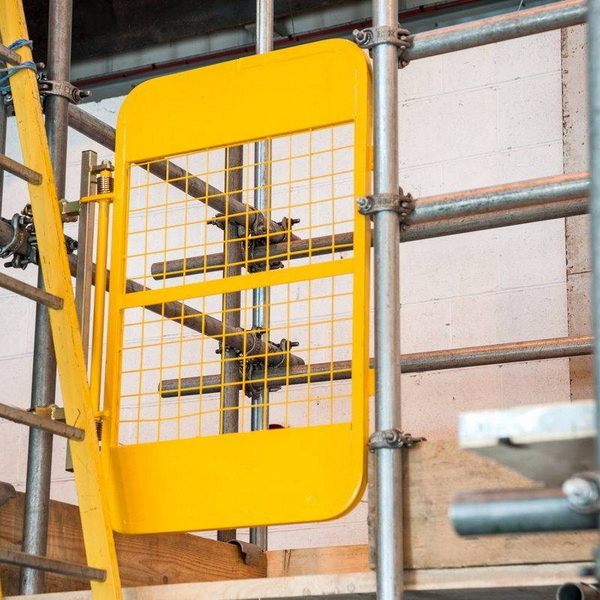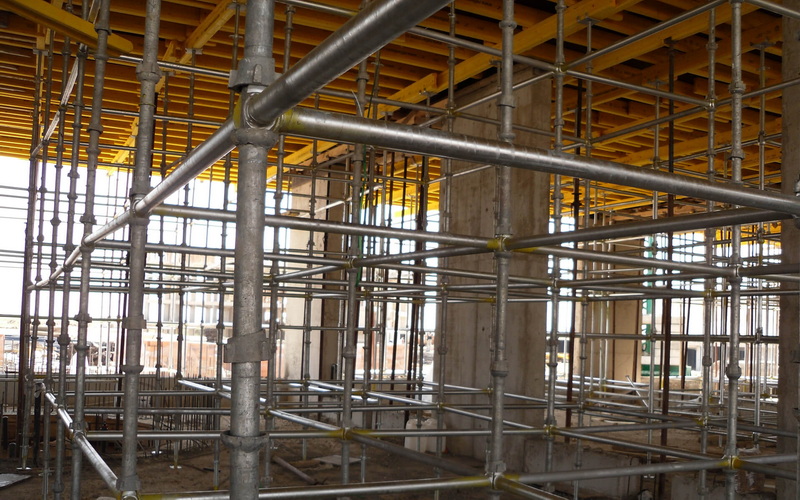Content Menu
● Key Safety Features of Cuplock Scaffolding
● Common Hazards When Using Cuplock Scaffolding
● Safety Protocols for Using Cuplock Scaffolding
>> 1. Pre-Erection Inspections
>> 2. Proper Assembly Techniques
>> 3. Load Management
>> 4. Installation of Safety Features
>> 5. Regular Inspections
>> 6. Training and Supervision
● Step-by-Step Guide: Ensuring Safety During Use
>> Step 1: Site Preparation
>> Step 2: Erect the Scaffold Safely
>> Step 3: Monitor Usage
>> Step 4: Respond to Hazards
● Best Practices for Scaffold Safety
● Common Mistakes in Scaffold Safety
● Advantages of Following Safety Protocols
● Conclusion
● FAQ
>> 1. What are the key safety features of Cuplock scaffolding?
>> 2. How often should scaffolds be inspected?
>> 3. What PPE is required when working on Cuplock scaffolding?
>> 4. Can Cuplock scaffolding be used during bad weather?
>> 5. What regulations apply to scaffold safety?
● Citations:
Cuplock scaffolding is a modular system widely used in construction for its efficiency, adaptability, and safety. While it provides a stable platform for workers at heights, ensuring safety during its use is critical to prevent accidents and injuries. This article explains how to ensure safety when using Cuplock scaffolding, including best practices, safety protocols, and common hazards to watch for.

Key Safety Features of Cuplock Scaffolding
Cuplock scaffolding is designed with several built-in safety features that make it reliable for construction projects:
1. Unique Locking Mechanism:
- The metal cups securely connect horizontal and vertical components, minimizing the risk of dislodgement.
2. High Load-Bearing Capacity:
- Made from high-tensile steel, Cuplock scaffolding can support heavy loads without compromising stability.
3. Modular Design:
- Quick assembly and disassembly reduce the time workers spend at risk during scaffold erection.
4. Safety Accessories:
- Includes guardrails, toe boards, and netting to protect workers from falls and falling objects.
Common Hazards When Using Cuplock Scaffolding
Despite its robust design, improper use of Cuplock scaffolding can lead to accidents. Common hazards include:
1. Falls from Heights:
- Workers can fall if guardrails or platforms are not properly installed.
2. Structural Instability:
- Overloading or incorrect assembly can compromise scaffold stability.
3. Falling Objects:
- Tools or materials can fall from platforms, posing risks to workers below.
4. Weather Conditions:
- Strong winds or rain can destabilize scaffolds and increase slip risks.
5. Dislodged Components:
- Improper locking of ledgers or braces can cause parts to detach under load.
Safety Protocols for Using Cuplock Scaffolding
1. Pre-Erection Inspections
- Inspect all components for damage or wear before assembly.
- Ensure base jacks are placed on stable ground to prevent uneven loading.
2. Proper Assembly Techniques
- Follow manufacturer guidelines for erecting Cuplock scaffolding.
- Use a spirit level to ensure vertical standards are aligned correctly.
- Secure all connections tightly using the cup-and-blade mechanism.
3. Load Management
- Do not exceed the recommended load capacity of the scaffold.
- Distribute weight evenly across platforms to prevent tipping or collapse.
4. Installation of Safety Features
- Install guardrails and toe boards at all working levels.
- Use netting or barriers to catch falling objects.
5. Regular Inspections
- Conduct daily inspections to check for loose connections or misaligned components.
- Inspect scaffolds after adverse weather conditions or modifications.
6. Training and Supervision
- Provide workers with training on scaffold erection and safe usage.
- Ensure a competent person supervises scaffold assembly and use.

Step-by-Step Guide: Ensuring Safety During Use
Step 1: Site Preparation
- Clear the area around the scaffold of debris and obstacles.
- Barricade the scaffold area with warning signs to prevent unauthorized access.
Step 2: Erect the Scaffold Safely
- Assemble the base level first, ensuring standards are securely attached to base jacks.
- Add ledgers, braces, and planks gradually while checking alignment at each level.
- Install safety features like guardrails before moving higher.
Step 3: Monitor Usage
- Limit the number of workers on each platform based on load capacity.
- Ensure workers wear personal protective equipment (PPE), including helmets, gloves, and harnesses.
Step 4: Respond to Hazards
- Address loose components immediately during inspections.
- Avoid using scaffolds during adverse weather conditions such as storms or high winds.
Best Practices for Scaffold Safety
1. Use PPE:
- Helmets, gloves, harnesses, and non-slip boots are essential for worker safety.
2. Follow Regulations:
- Adhere to OSHA standards or local regulations regarding scaffold height, guardrail installation, and load limits.
3. Anchor Tall Scaffolds:
- Use guying or ties when scaffold height exceeds a 4:1 height-to-base ratio.
4. Avoid Overloading Platforms:
- Ensure platforms support at least four times their intended load without deflection.
5. Provide Emergency Training:
- Train workers on emergency procedures in case of structural failure or falls.
Common Mistakes in Scaffold Safety
1. Skipping Inspections:
- Failure to inspect scaffolds regularly increases risks of accidents due to unnoticed damage or wear.
2. Improper Assembly:
- Misaligned components can compromise structural integrity.
3. Ignoring Weather Conditions:
- Using scaffolds during storms or high winds increases slip risks and instability.
4. Omitting Safety Features:
- Lack of guardrails or toe boards increases fall risks significantly.
Advantages of Following Safety Protocols
Ensuring safety when using Cuplock scaffolding offers numerous benefits:
1. Reduced Accidents:
- Proper safety measures minimize risks of falls, injuries, and fatalities.
2. Improved Efficiency:
- Workers feel more secure when safety protocols are followed, leading to higher productivity.
3. Compliance with Regulations:
- Adhering to OSHA guidelines avoids legal penalties and ensures worker protection.
4. Extended Scaffold Lifespan:
- Regular inspections and proper usage reduce wear and tear on components.
Conclusion
Safety is paramount when using Cuplock scaffolding in construction projects. By following preemptive measures such as regular inspections, proper assembly techniques, load management, training programs, and adherence to regulations like OSHA standards, construction teams can minimize risks while maximizing efficiency on-site. Investing in worker safety not only prevents accidents but also ensures compliance with industry standards and enhances project outcomes.

FAQ
1. What are the key safety features of Cuplock scaffolding?
Cuplock scaffolding includes features like secure locking mechanisms, high load-bearing capacity, guardrails, toe boards, and modular design for safe assembly and usage.
2. How often should scaffolds be inspected?
Scaffolds should be inspected daily before use and after any adverse weather conditions or structural modifications to ensure stability and compliance with safety standards.
3. What PPE is required when working on Cuplock scaffolding?
Workers should wear helmets, gloves, harnesses, non-slip boots, and other protective gear suitable for working at heights.
4. Can Cuplock scaffolding be used during bad weather?
No, it is unsafe to use scaffolds during strong winds, heavy rainstorms, or icy conditions as these increase slip risks and structural instability.
5. What regulations apply to scaffold safety?
In most regions, OSHA guidelines dictate scaffold height limits, guardrail installation requirements, load capacities, anchoring systems for tall scaffolds (above a 4:1 height-to-base ratio), and training protocols for workers at heights.
Citations:
[1] https://safetyculture.com/topics/scaffolding-safety/
[2] https://www.wm-scaffold.com/cup-lock-scaffold.html
[3] https://www.scaffoldingsolutions.com/articles/recent-scaffolding-safety-guidelines/
[4] https://constrofacilitator.com/the-versatility-of-cuplock-scaffolding-systems-in-modern-construction/
[5] https://www.worksafe.qld.gov.au/news-and-events/alerts/workplace-health-and-safety-alerts/2023/fall-risk-with-ring-lock-type-scaffolding
[6] https://www.sparsteel.com/blog/cuplock-scaffolding-types-uses-and-benefits/
[7] https://www.indiamart.com/proddetail/cuplock-scaffolding-8568016030.html






















